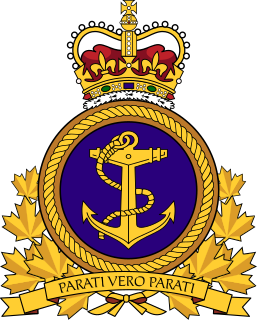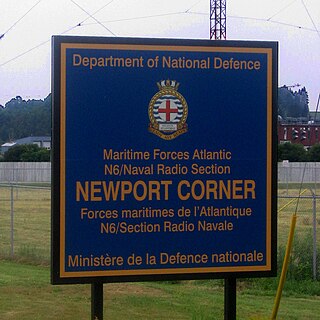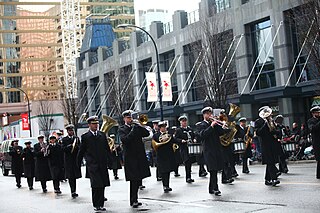See also
- List of Naval Reserve divisions for a list of Canadian Forces Naval Reserve facilities, some of which were used by the RCN's reserve.
This is a list of shore-based facilities operated by the Royal Canadian Navy (RCN) from its creation in 1911 until unification into the Canadian Forces on February 1, 1968.
All RCN shore-based facilities in this period followed the naming tradition of the Royal Navy, whereby the prefix HMCS or Naval Radio Station (NRS), was affixed. This tradition is somewhat maintained under the RCN's successor, Canadian Forces Maritime Command where certain facilities such as HMCS Trinity and NRS Aldergrove, are still formally referred to in this fashion, likely out of tradition, however the entire bases at the deep water ports of Victoria and Halifax are now referred to as a Canadian Forces Base or CFB. For Canadian Forces Bases operated by the modern Royal Canadian Navy see Canadian Forces Bases#Royal Canadian Navy.

The Royal Canadian Navy is the naval force of Canada. The RCN is one of three environmental commands within the Canadian Armed Forces. As of 2021, the RCN operates 12 frigates, four attack submarines, 12 coastal defence vessels, eight patrol class training vessels, one offshore patrol vessels, and several auxiliary vessels. The RCN consists of 8,570 Regular Force and 4,111 Primary Reserve sailors, supported by 3,800 civilians. Vice-Admiral Craig Baines is the current commander of the Royal Canadian Navy and chief of the Naval Staff.

Royal Canadian Air Force Base Shearwater, commonly referred to as RCAF Shearwater, was a Canadian Forces base located 4.5 nautical miles east southeast of Shearwater, Nova Scotia, on the eastern shore of Halifax Harbour in the Halifax Regional Municipality. Following a base rationalization program in the mid-1990s, the Canadian Forces closed CFB Shearwater as a separate formation and realigned the property's various facilities into CFB Halifax. These include:

A Canadian Forces base or CFB is a military installation of the Canadian Armed Forces. For a facility to qualify as a Canadian Forces base, it must station one or more major units.
Canadian Forces Base (CFB) Halifax is Canada's east coast naval base and home port to the Royal Canadian Navy Atlantic fleet, known as Canadian Fleet Atlantic (CANFLTLANT), that forms part of the formation Maritime Forces Atlantic (MARLANT).

Canadian Forces Base Esquimalt is Canada's Pacific Coast naval base and home port to Maritime Forces Pacific and Joint Task Force Pacific Headquarters. As of 2018, 4,411 military personnel and 2,762 civilians work at CFB Esquimalt.

Canadian Forces Base Gander, is a Canadian Forces base located in Gander, Newfoundland and Labrador. It is operated as an air force base by the Royal Canadian Air Force and is home to search and rescue operations that cover a vast swath of the western North Atlantic and southern Arctic and a Canadian Coastal Radar station amongst other things. It is home to 9 Wing Gander.

HMS Shearwater was a Condor-class sloop launched in 1900. She served on the Pacific Station and in 1915 was transferred to the Royal Canadian Navy as HMCS Shearwater, serving as a submarine depot ship until 1919. She was sold to the Western Shipping Company in May 1922 and renamed Vedas.

Esquimalt Royal Naval Dockyard was a major British Royal Navy yard on Canada's Pacific coast from 1842 to 1905, subsequently operated by the Canadian government as HMC Dockyard Esquimalt, now part of CFB Esquimalt, to the present day.
Naval Radio Section Aldergrove, or NRS Aldergrove, is a Canadian Forces naval radio communications facility located in both Aldergrove and Matsqui, British Columbia.

Canadian Forces Base Cornwallis is a former Canadian Forces Base located in Deep Brook, Nova Scotia.
In the Canadian Forces, Maritime Forces Atlantic (MARLANT) is responsible for the fleet training and operational readiness of the Royal Canadian Navy in the Atlantic Ocean and Arctic Ocean. It was once referred to as Canadian Atlantic Station.

Naval Radio Section Newport Corner is a Canadian Forces naval radio station located in Brooklyn, Nova Scotia. Founded in 1942, it is still in operation today but remotely controlled from CFB Halifax.
Canadian Forces Station Mill Cove is a former Canadian Forces Station and currently a naval radio station located near Hubbards, Nova Scotia. Built in 1967, it is remotely operated by the Canadian Forces from CFB Halifax.

In the Canadian Forces, Maritime Forces Pacific is responsible for the fleet training and operational readiness of the Royal Canadian Navy in the Pacific Ocean. It was once referred to as Canadian Pacific Station.
The Royal Naval College of Canada (RNCC) was established by the Department of the Naval Service after the formation of the Royal Canadian Navy (RCN) in 1910. The college was placed under the auspices of the Minister of Naval Service and controlled by the Director of the Naval Service, Rear-Admiral Charles Kingsmill. The initial goal was to train a new generation of Canadian naval officers for the RCN. The college existed from 1911 to 1922 and educated about 150 students until it was closed due to declining numbers and budget cuts by the government of Canada. As the RCN did not have large ships of its own other than HMCS Niobe and HMCS Rainbow, the cadets followed a course of study that would qualify them for eventual service on British warships. The graduated midshipmen were required to serve approximately one year of "big ship duty" as part of their training.

Canadian Forces Station Bermuda, commonly shortened to CFS Bermuda and popularly known as Daniel's Head, was a Canadian Forces Station in Bermuda that was operational from 1963 until 1992. Daniel's Head and Daniel's Island had previously been used by the militia, and the Royal Navy. A previous Canadian base, HMCS Somers Isles, had existed during the Second World War.

Canadian military bands are a group of personnel in the Canadian Armed Forces (CAF) that performs musical duties for military functions. Military bands form a part of the Music Branch of the CAF, composed of six full-time professional Regular Force bands, 15 Regular Force voluntary bands, and 53 part-time reserve force bands. Bands of the Music Branch are often badged with the unit or Canadian Forces base insignia that they support.

HMCS Nonsuch is a naval reserve division (NRD) located in Edmonton, Alberta. Dubbed a stone frigate, HMCS Nonsuch is a land-based naval establishment for part-time sailors as well as a local recruitment centre for the Canadian Forces Naval Reserve. It is one of 24 naval reserve divisions located in major cities across Canada.

The Naden Band of the Royal Canadian Navy is one of six regular force military bands of the Canadian Forces. The Royal Canadian Navy band is based at CFB Esquimalt in Esquimalt, British Columbia that serves as the official musical unit of the Canadian Forces Maritime Forces Pacific Command (MARPAC).

Navy bands in Canada are part of the Royal Canadian Navy's command structure and overseen by the Music Branch of the Canadian Forces and the Directorate of History and Heritage of the Department of National Defence.